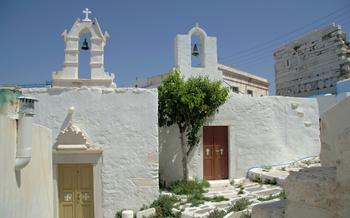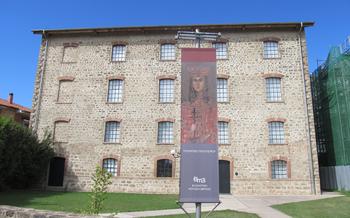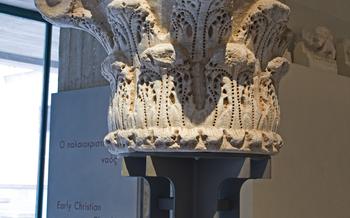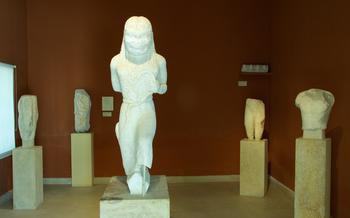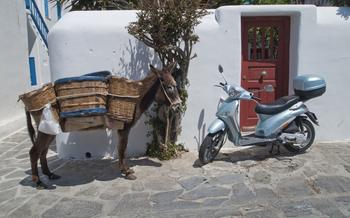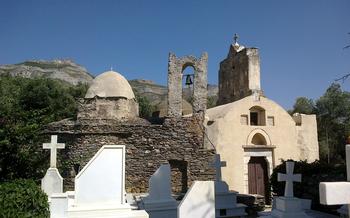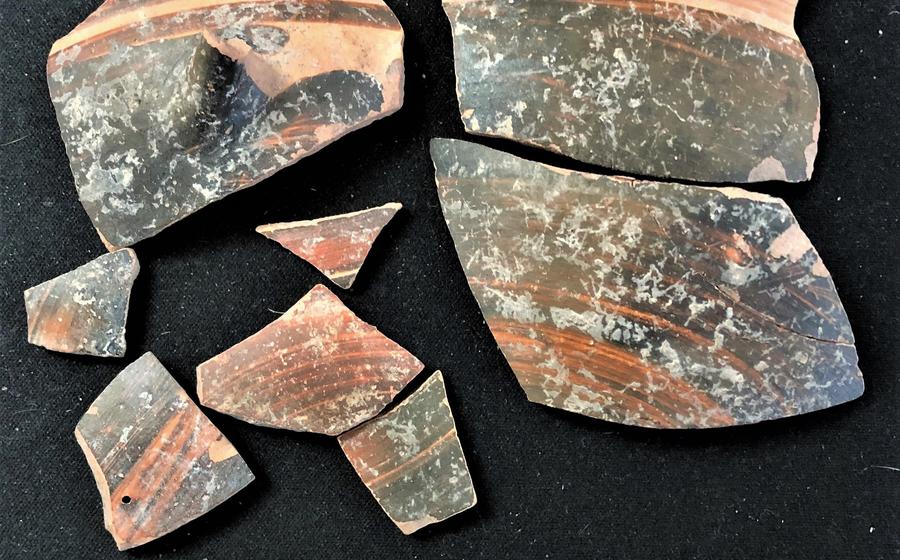
Byzantine Museum of Parikia
- The Byzantine Museum of Parikia: A Historical and Cultural Gem
- Location and Accessibility
- Hours of Operation and Admission Fees
- Exploring the Museum's Permanent Collection
- Guided Tours and Educational Programs
- The Museum's Historical Context
- Architectural Features and Design
- Interactive Exhibits and Multimedia Displays
- Museum Shop and Bookstore
- Accessibility for Visitors with Disabilities
- Photography and Social Media
- Nearby Attractions and Points of Interest
- Planning Your Visit: Tips and Recommendations
- Insider Tip: Hidden Gems and Secret Spots
The Byzantine Museum of Parikia: A Historical and Cultural Gem
Nestled in the heart of Parikia, the capital of Paros, the Byzantine Museum stands as a testament to the rich cultural heritage of the island. Established in 1960, the museum houses a remarkable collection of Byzantine artifacts that provide a glimpse into the artistic and religious traditions of the Byzantine Empire, which left an indelible mark on the history and culture of Greece. From exquisite icons and intricate manuscripts to impressive sculptures and decorative objects, the Byzantine Museum of Parikia offers a journey through time, inviting visitors to explore the splendor and spirituality of one of the most influential periods in Greek history.
The museum's collection is not only aesthetically captivating but also historically significant. It encompasses artifacts from the 6th to the 15th century, shedding light on the evolution of Byzantine art and its impact on the region. Whether you're an art enthusiast, a history buff, or simply curious about Greek culture, the Byzantine Museum of Parikia promises an immersive and enlightening experience.
Location and Accessibility
The Byzantine Museum of Parikia is conveniently located in the heart of the historic town of Parikia, on the beautiful island of Paros, in the Aegean Sea. The museum's exact address is Ekatontapyliani, Parikia 844 00.
Public transportation is readily available to reach the museum. From the port of Parikia, you can take a short and scenic walk or catch a local bus. The bus stop for "Parikia Center" is just a few steps away from the museum.
For those who prefer to drive, parking is usually available in the surrounding streets. However, during peak tourist season, it may be necessary to park a short distance away and walk to the museum.
Hours of Operation and Admission Fees
The Byzantine Museum of Parikia is open to the public daily, except for Mondays, from April to October. During this period, the opening hours are from 8:30 AM to 3:00 PM. From November to March, the museum operates on a reduced schedule, opening from 10:00 AM to 2:00 PM on Tuesdays, Wednesdays, Thursdays, and Saturdays. It remains closed on Sundays and public holidays.
Admission fees are affordable, encouraging visitors to explore the museum's treasures. Adult tickets are priced at €4, while children under 12 years of age and students with valid IDs are eligible for a discounted rate of €Group discounts are also available for parties of 10 or more, offering a reduced rate of €3 per person.
To make the museum accessible to a wider audience, free admission is granted to visitors with disabilities and their companions, as well as to children under 5 years of age. Additionally, the museum offers free entrance every first Sunday of the month, inviting locals and tourists alike to experience the wonders of Byzantine art without any financial barriers.
Exploring the Museum's Permanent Collection
The Byzantine Museum of Parikia houses a remarkable collection of Byzantine artifacts that provide a glimpse into the rich cultural heritage of the Cyclades region. Highlights include a stunning array of icons, each with its own unique history and artistic style. The museum also boasts an impressive collection of manuscripts, including illuminated gospels and religious texts. These manuscripts offer a glimpse into the intellectual and spiritual life of the Byzantine Empire. Finally, the museum's collection of sculptures includes intricate carvings, statues, and reliefs that depict scenes from the Bible and the lives of the saints. These sculptures showcase the exceptional craftsmanship and artistic skill of Byzantine artisans.
The museum's permanent collection is organized into several thematic sections or galleries. The first section focuses on the early Christian period and features artifacts from the 4th to the 7th centuries. The second section explores the Middle Byzantine period and includes works from the 8th to the 12th centuries. The third section focuses on the Late Byzantine period and features artifacts from the 13th to the 15th centuries. Each section provides a comprehensive overview of the artistic and cultural developments that occurred during these periods.
Guided Tours and Educational Programs
The Byzantine Museum of Parikia offers guided tours in various languages, including English, French, German, and Italian. These tours provide an in-depth exploration of the museum's collection, with knowledgeable guides sharing insights into the history, significance, and artistic techniques of the Byzantine artifacts.
Scheduled tours are available throughout the day, and visitors are encouraged to inquire at the museum's information desk for specific times and languages. There is a small additional fee for guided tours, which can be purchased separately from the museum's admission ticket.
For schools or groups, the museum offers tailored educational programs that align with specific curricula or interests. These programs can include interactive activities, hands-on workshops, and guided discussions. Advance booking is required for group visits and educational programs, and the museum staff can assist in customizing the experience to meet the needs of each group.
The Museum's Historical Context
Parikia, the capital of the island of Paros, boasts a rich history dating back to ancient times. As part of the Cyclades archipelago, it has been influenced by various civilizations, including the Byzantine Empire. During the Byzantine period (5th-15th centuries AD), Parikia flourished as a significant cultural and religious center. The Byzantine Museum of Parikia stands as a testament to this era, showcasing the deep imprint of Byzantine culture on the island.
The Cyclades region, where Paros is situated, played a pivotal role in the Byzantine Empire. Its strategic location in the Aegean Sea made it a vital hub for trade and commerce. Byzantine influence permeated every aspect of life on the island, from architecture and art to religious practices and daily customs. The Byzantine emperors maintained a strong presence in the region, commissioning churches, monasteries, and other structures that reflected their power and authority.
The establishment of the Byzantine Museum in Parikia serves as a tribute to this rich cultural heritage. The museum's collection encompasses a wide range of artifacts, including icons, manuscripts, sculptures, and decorative objects, all of which shed light on the Byzantine era's artistic achievements, religious beliefs, and cultural practices. By preserving and showcasing these treasures, the museum plays a vital role in safeguarding the island's unique identity and fostering a deeper understanding of its Byzantine roots.
Architectural Features and Design
The Byzantine Museum of Parikia is housed in a beautifully restored 17th-century Venetian building that showcases a harmonious blend of traditional Cycladic architecture and modern design. The museum's exterior features whitewashed walls adorned with blue-painted window frames, a characteristic element of Cycladic architecture. The building's arched doorways and intricate stone carvings add to its charm and historical significance.
Inside, the museum's layout is both functional and aesthetically pleasing. The spacious galleries are designed to provide ample space for displaying the extensive collection of Byzantine artifacts while maintaining a sense of intimacy and immersion. The use of natural light through large windows illuminates the exhibits and creates a warm and inviting atmosphere.
The museum's integration with the surrounding landscape is particularly noteworthy. The building's low-rise design and simple lines ensure that it does not overshadow the surrounding historical structures or disrupt the harmony of the picturesque town. The museum's courtyard, with its lush greenery and shaded seating areas, provides a tranquil oasis for visitors to relax and reflect on the cultural treasures they have just experienced.
Interactive Exhibits and Multimedia Displays
The Byzantine Museum of Parikia also boasts several interactive exhibits and multimedia displays that enhance the visitor experience. These interactive elements are designed to engage visitors, especially children, and provide a deeper understanding of the museum's collection.
Touchscreens and interactive maps allow visitors to explore the history of the Cyclades region and the Byzantine Empire. Multimedia presentations showcase the museum's artifacts in a dynamic and engaging manner, providing additional context and information.
The museum also utilizes augmented reality technology to bring history to life. Visitors can use their smartphones or tablets to scan QR codes and access interactive content, such as 3D models of artifacts or virtual tours of Byzantine churches.
These interactive exhibits and multimedia displays not only make the museum more accessible and engaging for visitors of all ages but also contribute to a more immersive and memorable experience.
Museum Shop and Bookstore
At the Byzantine Museum of Parikia, you'll find a well-stocked museum shop that offers a range of souvenirs and gifts inspired by the museum's collection. Browse through a selection of postcards, books, and educational materials that delve deeper into the history and culture of the Byzantine Empire. Support local artisans and promote Greek culture by purchasing unique handmade items, such as ceramics, jewelry, and textiles. The museum shop also features a variety of educational toys and games that are perfect for engaging children and sparking their interest in Byzantine history. Whether you're looking for a memento of your visit or a thoughtful gift for a loved one, the Byzantine Museum's shop has something for everyone.
Accessibility for Visitors with Disabilities
The Byzantine Museum of Parikia is committed to providing an inclusive and accessible experience for visitors with disabilities. The museum offers wheelchair-accessible ramps and elevators, ensuring that all visitors can navigate the museum's spaces with ease. Additionally, the museum provides special accommodations and assistance to visitors with disabilities, such as guided tours with sign language interpretation or tactile exhibits for visually impaired visitors. The museum staff is always available to assist visitors with disabilities, ensuring that everyone can have a fulfilling and enjoyable museum experience.
Photography and Social Media
The Byzantine Museum of Parikia encourages visitors to capture the beauty and significance of the collection through photography. However, certain guidelines must be followed to ensure the preservation of the artifacts and the comfort of other visitors. Flash photography is strictly prohibited to prevent damage to the delicate artworks. Visitors are also reminded to be respectful of other guests and maintain a quiet environment within the museum.
Sharing the museum experience on social media is not only encouraged but also appreciated. Visitors are invited to use the museum's official hashtags and tag the institution in their posts. The museum actively engages with its online community, sharing behind-the-scenes glimpses, event announcements, and interesting stories related to the collection. Using social media to promote the museum's offerings not only helps spread awareness but also contributes to the preservation and appreciation of Byzantine art and culture.
Nearby Attractions and Points of Interest
The Byzantine Museum of Parikia is situated in the heart of the picturesque old town, making it an ideal starting point for exploring the town's other historical and cultural attractions. Just a short stroll away, visitors can admire the imposing Venetian Castle of Parikia, a symbol of the island's rich history.
The Castle, built in the 13th century, offers breathtaking panoramic views of the town and the Aegean Sea. Parikia's old town is a labyrinth of narrow, winding streets, lined with traditional Cycladic houses, charming boutiques, and inviting tavernas. Getting lost in these streets is part of the charm, as visitors can stumble upon hidden gems like the Folklore Museum of Parikia, showcasing the island's rich cultural heritage.
For those seeking a spiritual experience, the historic Panagia Ekatontapyliani Church, located just outside the old town, is a must-visit. This Byzantine church, dating back to the 4th century, is one of the most important religious monuments in the Cyclades.
Combining a visit to the Byzantine Museum with a stroll through the old town and exploring these nearby attractions provides a comprehensive immersion into the history, culture, and beauty of Parikia and the island of Paros.
Planning Your Visit: Tips and Recommendations
To make the most of your visit to the Byzantine Museum of Parikia, planning is key. Here are some helpful tips and recommendations:
-
Avoid the Crowds: If you want a more tranquil experience, plan your visit outside of peak tourist season (typically July and August). The museum is usually less crowded in the morning, so aim to arrive early.
-
Best Time to Visit: Spring (April-May) and autumn (September-October) offer pleasant weather and fewer crowds, making them ideal times to visit. The museum's picturesque courtyard provides a serene setting to relax and soak in the history.
-
Combine and Conquer: Take advantage of Parikia's compact size and combine your museum visit with other nearby attractions. Stroll through the charming old town, visit the Panagia Ekatontapyliani church, and explore the Folklore Museum of Cycladic Art.
Insider Tip: Hidden Gems and Secret Spots
Beyond the main exhibition halls, the Byzantine Museum of Parikia holds hidden treasures that await discovery. As you wander through the galleries, keep an eye out for the museum's rooftop terrace, offering panoramic views of the picturesque town and the Aegean Sea. On a clear day, you can even spot the neighboring islands of Naxos and Antiparos.
Venture into the museum's nooks and crannies to uncover lesser-known exhibits. In a secluded corner, you might find a beautifully preserved mosaic depicting scenes from ancient Greek mythology. Or, stumble upon a hidden room housing a collection of rare manuscripts, each telling a unique story from the island's Byzantine past.
Ask the museum staff about special events or workshops that may be taking place during your visit. These events often provide exclusive access to behind-the-scenes areas or offer the chance to engage with experts in Byzantine art and history.
Finally, take some time to explore the museum's gift shop, where you can find unique souvenirs and gifts inspired by the Byzantine collection. From replicas of ancient artifacts to handmade jewelry featuring traditional Greek motifs, there's something for every taste and budget.

